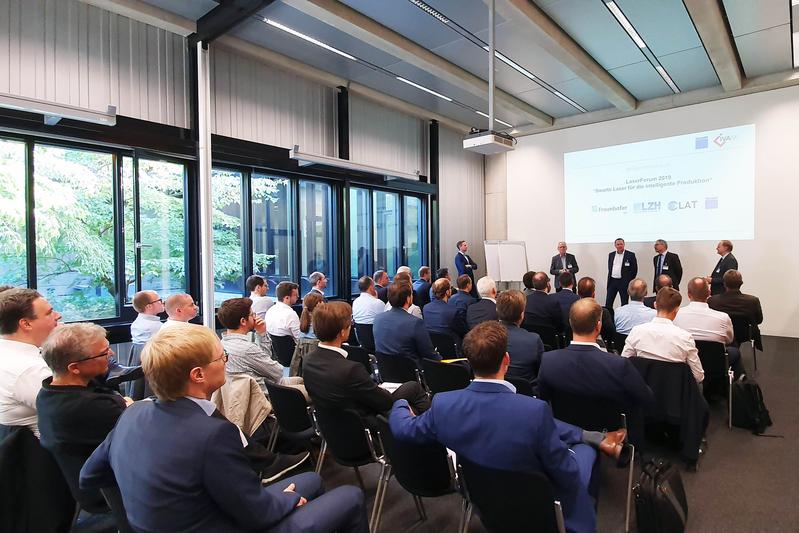
Smart lasers open up new applications and are the “tool of choice” in digitalization

At the annual "LaserForum", selected questions and trends regarding the use of laser technology in various application sectors are discussed.
IVAM
Laser is the “tool of choice” for industry 4.0
The presentations and discussions during the event showed that lasers in particular can be an optimal tool for introducing industry 4.0 concepts into production. Laser processes are ideally suited for digitalized and individualized production.
They are often simpler and faster than conventional, mechanical manufacturing processes and especially suited for very individual products compared to e.g. parallel etching or molding processes that have been developed for large numbers of the same products.
Philipp Becker from Vision Lasertechnik started the event with a keynote speech explaining how digitalization can change production. For Dr. Joachim Ryll of Pulsar Photonics, “intelligent” machines are still a dream of the future.
The “intelligence” of a process lies rather in the meaningful combination of automated processes and the collection and evaluation of all available data in order to make the right decisions for the production process. At the end of the event, Markus Galter explained how a machine manufacturer like TRUMPF implements this in practice.
Smart laser-based production processes and systems
Digitalization in production also requires smart production processes and plant technologies. As examples, UKP laser processing in liquids (Alexander Kanitz, Chair of
Applied Laser Technologies at Ruhr-Universität Bochum), water-jet-guided laser processing with IR lasers (Jeroen Hribar, Avonisys) or movable micro mirrors as scanners for laser material processing (Dr. Ulrich Hofmann, OQmented) were presented. Dr. Ulf Quentin (TRUMPF) presented examples of high-precision manufacturing processes with lasers.
In particular, glass processing for displays or mobile phone covers requires the highest accuracy at high cost pressure. Martin Hermatschweiler (nanoscribe) showed the high accuracies with which 3D printing processes now work, so that lenses and micro-optics can be produced.
New applications through smart laser technology
The presentations by Dr. Arnold Gillner (Fraunhofer Institute for Laser Technology) and Dr. Stefan Kaierle (Laser Zentrum Hannover) impressively demonstrated how the digitalization of production can also lead to new applications. Dr. Gillner showed the variety of possibilities for the production of electronic components.
Especially for applications on curved surfaces or on flexible substrates such as foils or fabrics laser processes can enable high-precision structuring of electronic components in the roll-to-roll process. Applications in wearables (portable electronics), in medical technology or on aircraft wings are becoming possible.
3D printing on the moon: first experiments 2022
Dr. Kaierle presented a project in which required components can be produced on the moon using 3D printing. The raw material would not be brought from the earth in order to save the costs of some €100.000 per kilogram for transport: because “moon dust is available on the moon in large quantities. It consists of regolith, which can be used well for 3D printing with laser processes. The ideas range from the production of traffic routes on the moon to the construction of residential buildings. The first experiments will be carried out on the moon in 2022.
All in all, the event showed what new chances are possible through automation and digitalization. New processes, new products and new technologies are emerging. As Dr. Gillner rightly described, a few hundred years ago only handmade products were possible. They were very individual, tailored to the wishes of the buyers.
Then the industrial revolution came, which required large series of the same products for low-cost mass production. (Henry Ford: “Any customer can have a car painted any color that he wants so long as it is black.”) But today, the trend goes back to individualized products that are tailored to the customer, his wishes and needs.
The batch size for series goes towards “1”. Nevertheless, the manufacturing costs should be low. This challenge can only be met with flexible production methods such as those offered by laser technology.
Laser technology celebrates its anniversary in 2020
Next year, the first laser will celebrate its 60th anniversary: Theodore Harold Maiman had developed the ruby laser in 1960. This will be the occasion for discussing the development of laser sources at the next LaserForum on October 6, 2020, to show today’s fields of application and to give an outlook on future developments. The annual event series LaserForum is organized by the IVAM Microtechnology Network together with the renowned partners Fraunhofer Institute for Laser Technology ILT, Laser Zentrum Hannover e.V. and the Chair of Applied Laser Technologies (LAT) of the Ruhr University Bochum (RUB).
https://www.ivam.de/news/smart_lasers_open_up_new_applications_and_are_the_tool_…












